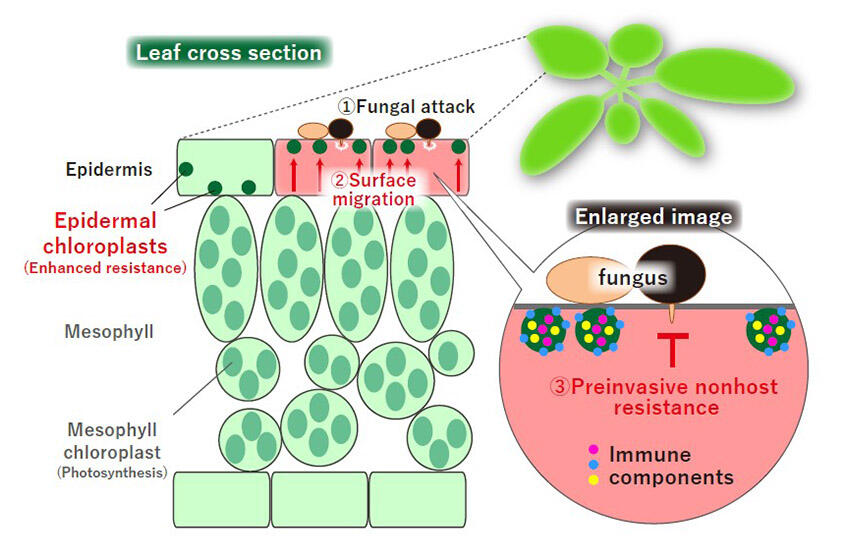On May 20, Assistant Professor Hiroki Irieda of the Faculty of Agriculture, Shinshu University, and Professor Yoshitaka Takano of the Graduate School of Agriculture, Kyoto University reported that small chloroplasts (epidermal chloroplasts) present in plant epidermal cells are involved in defense responses against fungal pathogens. A phenomenon in which Arabidopsis epidermal chloroplasts migrate to the surface layer in response to fungal pathogens was discovered, and upon investigation, it was confirmed that the epidermal chloroplasts have an immune-related function which prevents the invasion of fungal pathogens. Enhancing and controlling this function may enable us to reduce disease incidence in plants. Furthermore, it is expected to result in improvement of crop productivity and other related fields. The results were published in the British scientific journal "Nature Communications."
Approximately 20% of damage to global agricultural production is attributed to diseases resulting from microbial action, of which approximately 80% are caused by filamentous fungi. Plant surfaces are covered with hard epidermal cells, which prevent damage caused by the external environment and pests, whereas the inner cells, called mesophyll cells, have chloroplasts in which photosynthesis is carried out. Chloroplasts are generally not present in the plant epidermal cells of higher plants; but some plants, such as tobacco, have small chloroplasts (epidermal chloroplasts). Recently, chloroplasts were reported to be present in Arabidopsis, but their role and significance are unknown. By studying the anthracnose causing fungal pathogen and the survival strategies used in response by plants, the research group discovered a phenomenon in which epidermal chloroplasts in Arabidopsis migrate to the surface layer (surface migration) in response to the pathogen. The researchers named this phenomenon "epidermal chloroplast response" (ECR). Functional analysis was performed to validate the involvement of epidermal chloroplasts in immunity.
There are multiple types of anthracnose fungi. Each type is capable of infecting certain host plants; Arabidopsis is infected by an adapted brassica anthracnose fungus. When conidia attach to the surface of a plant, they form darkly pigmented cells called appressoria, from which they extend a needle-like organs to puncture the cuticle and cell wall of their host epidermal cells. Their hyphae then invade the host and grow and elongate inside.
In this study, the researchers first examined the type of anthracnose fungi that epidermal chloroplasts respond to. Arabidopsis was inoculated with an adapted brassica fungus, and nonadapted cherry (Sakura), cosmos, apple, and cucurbit fungi. The movement of epidermal chloroplasts was then observed over a period of 3 days.
Little surface migration was observed in the plant inoculated with the brassica fungus. In contrast, the four nonadaptive types resulted in an increase in the number of surface-migrating epidermal chloroplasts over time. Usually, epidermal chloroplasts are present in the edges or bottom of the cell. The chloroplasts appeared to migrate to the surface layer in response to the fungi. Thus, a transgenic Arabidopsis plant was created that overexpresses the protein chloroplast unusual positioning 1 (CHUP1), which is involved in the movement of common chloroplasts. The wild-type and CHUP1-overespressing Arabidopsis plants were inoculated with non-adapted forms of anthracnose fungi to observe epidermal chloroplast movement.
When the migration rate was compared to the wild-type, there was almost no migration of chloroplasts seen in the CHUP1-overexpressing plants and the rate of fungal invasion increased as surface migration rate decreased. The invasion rate of the cherry strain was approximately 15% in the wild-type plants but was significantly higher at approximately 46% in the CHUP1-overexpressing plants, in which surface migration was absent. This indicates that surface migration may be involved in defense responses that prevent the invasion of fungal pathogens. CHUP1 is a protein that interacts with actin and is involved in the movement of mesophyll chloroplasts, so it is possible that the movement of chloroplasts in the epidermal cells also functions in the similar manner.
When epidermal chloroplasts were examined, focusing on immune components, it was confirmed that the immune components GSH1, EDS5, and CAS were specifically accumulated in epidermal chloroplasts. These immune components were scarcely detected in the chloroplasts of mesophyll cells. Since all of these components are involved in immunity against the invasion of anthracnose fungi, it was suggested that epidermal chloroplasts play a role in controlling their subcellular positioning to prevent fungal invasion.

Credit: Hiroki Irieda, Shinshu University
In the future, these researchers will further investigate the function of epidermal chloroplasts and ascertain whether they are present in other plants. They will also verify whether disease resistance can be strengthened by controlling the functions of epidermal chloroplasts. According to Assistant Professor Irieda, "The small chloroplasts of the epidermal cells were considered mysterious organelles that have little role in photosynthesis; however, we have now shown that they are plant organelles that prevent fungal invasion and are involved in immunity. I believe that this study has enabled us to get a glimpse of the significance of their existence."
This article has been translated by JST with permission from The Science News Ltd.(https://sci-news.co.jp/). Unauthorized reproduction of the article and photographs is prohibited.




